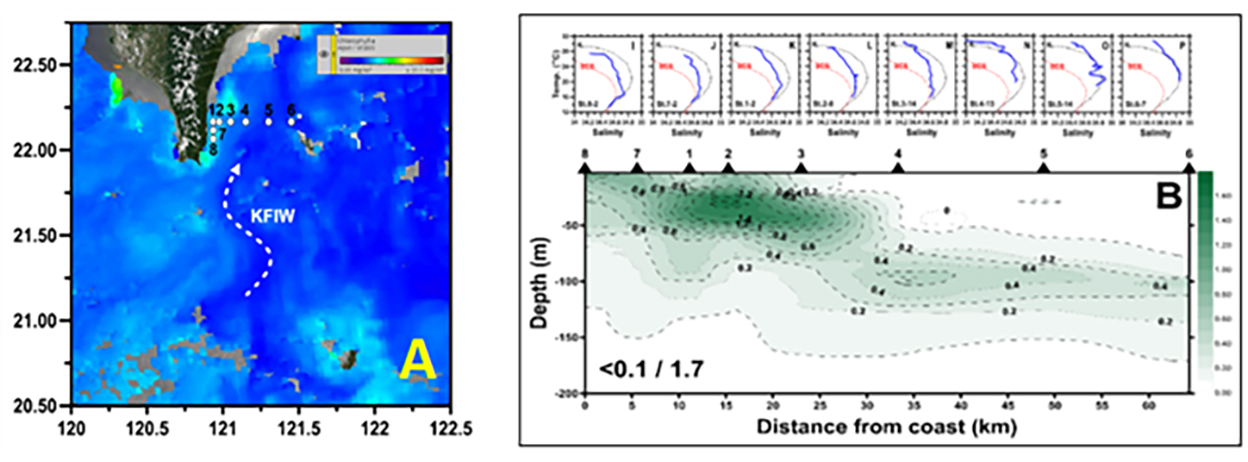


Figure 1. Map of southern Taiwan shows (A) the sampling stations across the mainstream of the Kuroshio. And (B) the spatial changes of the T-S diagrams (upper panel) and chlorophyll-a concentrations (lower panel) and along the sampling transect.
The West Boundary Current of the northwest Pacific i.e. Kuroshio Current - impacts our climate, economy, culture, and history by the heat and momentum it carries. Under the premise of establishing a marine country, we have long ignored this mega biome flowing by the east coast of Taiwan. Its impact on Blue Carbon (biological pump) and local fisheries (e.g. skipjack) and dolphin/whale watching tourism under a warming climate are still unknown.
Originating from the North Equatorial Current, the warm Kuroshio Current flows along the east coast of Taiwan had been viewed as a “desert” due to a limited supply of inorganic nutrients and low biological biomass/activity. Recent studies revealed satellite images showing high chlorophyll-a concentration in this area. Potential mechanisms behind this are worth exploring.
A survey in July 2020 was performed at a transect with 8 stations across the Kuroshio current east of Taiwan (Fig. 1A). The T-S diagram (Fig. 1B upper panel) indicated that water in stations 8, 7, 1, 2 and 3 was a mixture of the Kuroshio Current (KC) and South China Sea (SCS) water. While that of stations 4, 5, and 6 were more and more comparable to the Kuroshio Current water. We suspected that the vertical shear/mixing between the above-mentioned two water masses could generate changes in physical, chemical, and thus biological properties in this area.
In the euphotic zone (~100 m depth), the average values of primary production (3.46 ± 1.37 mgC m-3 d-1) of station 2 were ca. 4 folds of station 6 (0.91 ± 0.47 mgC m-3 d-1). The averaged bacterial production showed the same trend with lower and higher values in station 6 (1.00 ± 0.22 mgC m-3 d-1) and station 2 (1.17 ± 0.40 mgC m-3 d-1) respectively (Fig. 2A). The numerically simulated flow pattern (Fig. 2B-C) presented a typical summer circulation regime when the southwest monsoon prevailed over the study area. After leaving the northern tip of Luzon Island, the northward-flowing KC mainstream followed a relatively straight pathway bypassing the Luzon Strait with less westward intrusion into SCS. That is, most of the KC water returned to the east and continued its northward flow along the east coast of Taiwan (blue arrow). Meanwhile, a northeastward flowing branch originating from the SCS (red arrow) joined the western flank of the KC off southeast Taiwan.
This study for the first time demonstrates that the high biological biomass and activities that occur in KC are induced by the northward intrusion of the SCS waters. The high chlorophyll-a concentration and primary production might be one of the causes of the abundant flying fish (skipjack), dolphins, and whales. Note that the “new production” driven by the new nutrients from mixing/eddy processes in this region probably is particularly important since there is almost no shelf on the east coast of Taiwan. The sinking particles in productive areas could be transported to the deep sea very quickly.
Key points
More information

Figure 2. (A) A scatter plot of primary production vs. bacterial production. Open and solid dots represented data measured at stations 6 and 2 respectively. And a three-dimensional numerical simulation of (B) the paths of the currents based on backward-trajectory analyses, and (C) flow patterns of the 15 m depth velocity (vector) and vorticity (shading) on July 22nd, 2020. The horizontal color bar in (B) indicated the percentage for the arrival of the floater. The percentage is 100% in the releasing position (Station 2; red dot; 121.1 oE 22.15 oN). The red line in (C) indicated the sampling transect.